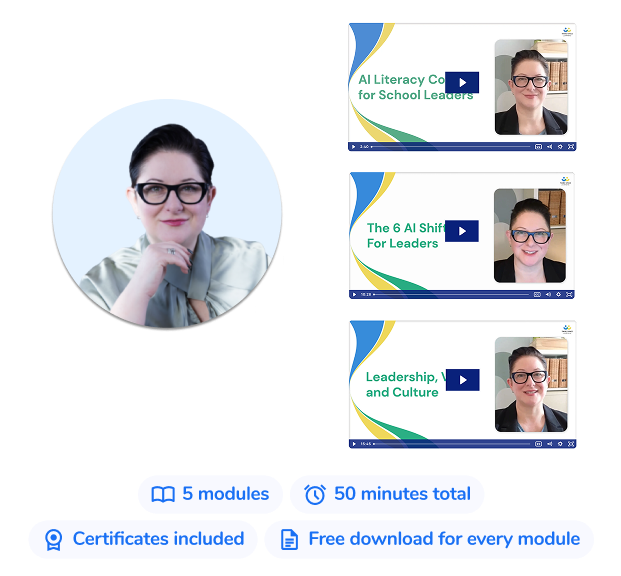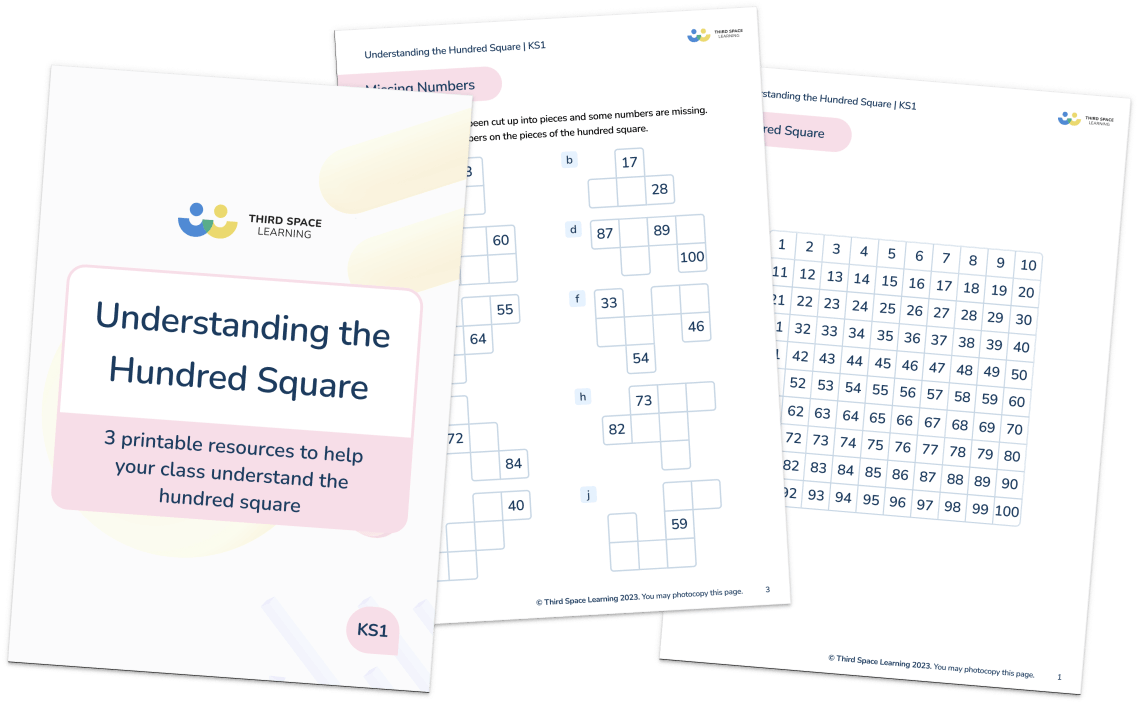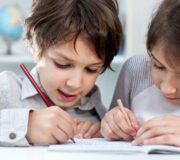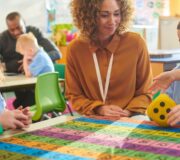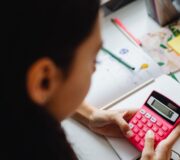10 Of The Best 100 Square Activities For Primary School
100 squares are versatile and inexpensive teaching resources and visual aids that can be used across the primary mathematics curriculum. From counting activities in EYFS and Year 1 through to addition and subtraction and even times tables and fractions in Key Stage 2.
In this blog, we consider a variety of different activities to ensure that you are making the most out of this versatile resource, whichever primary year group you are teaching.
What is a 100 square?
A 100 square is a 10×10 square that typically contains the numbers 1-100.
The numbers are in sequential order and, since our number system is base-10, this means that all numbers with the same ones digit can be found in the same column. This can begin to give children a basic understanding of place value.
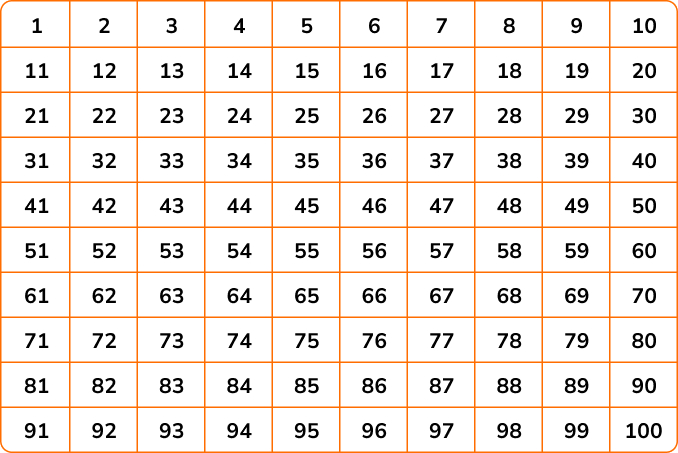
Understanding the Hundred Square
3 printable resources to help your class understand the hundred square and numbers from 1 to 100.
Download Free Now!Hundred squares are familiar to many of our youngest children as they are the basis of games such as snakes and ladders. This familiarity makes them seem less daunting to children who find numeracy tricky.
Other number squares have the numbers 0-99 instead. Unlike the hundred square shown above, these squares have the advantage of both numbers with the same ones digit in the same column, and numbers with the same tens digit in the same row.
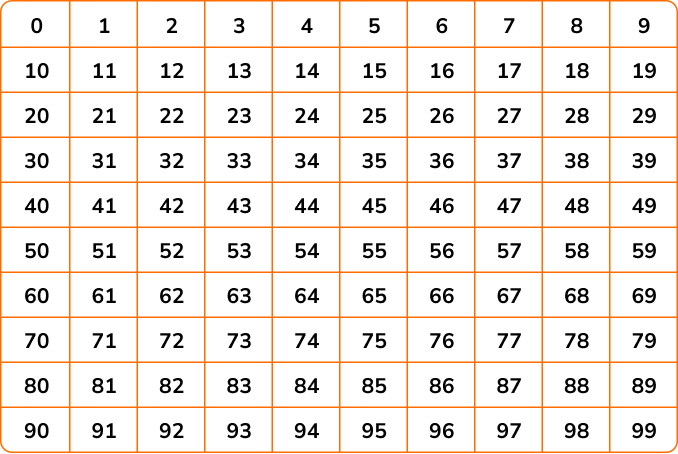
You can also use a blank 10×10 square as a number square which may be useful when thinking about numbers smaller than 1.
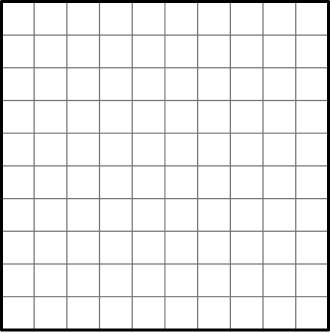
When do children use 100 squares in school?
Hundred squares can be used by children from Early Years through to Year 6. Children can use them as a tool to gain understanding of a topic and to support their reasoning.
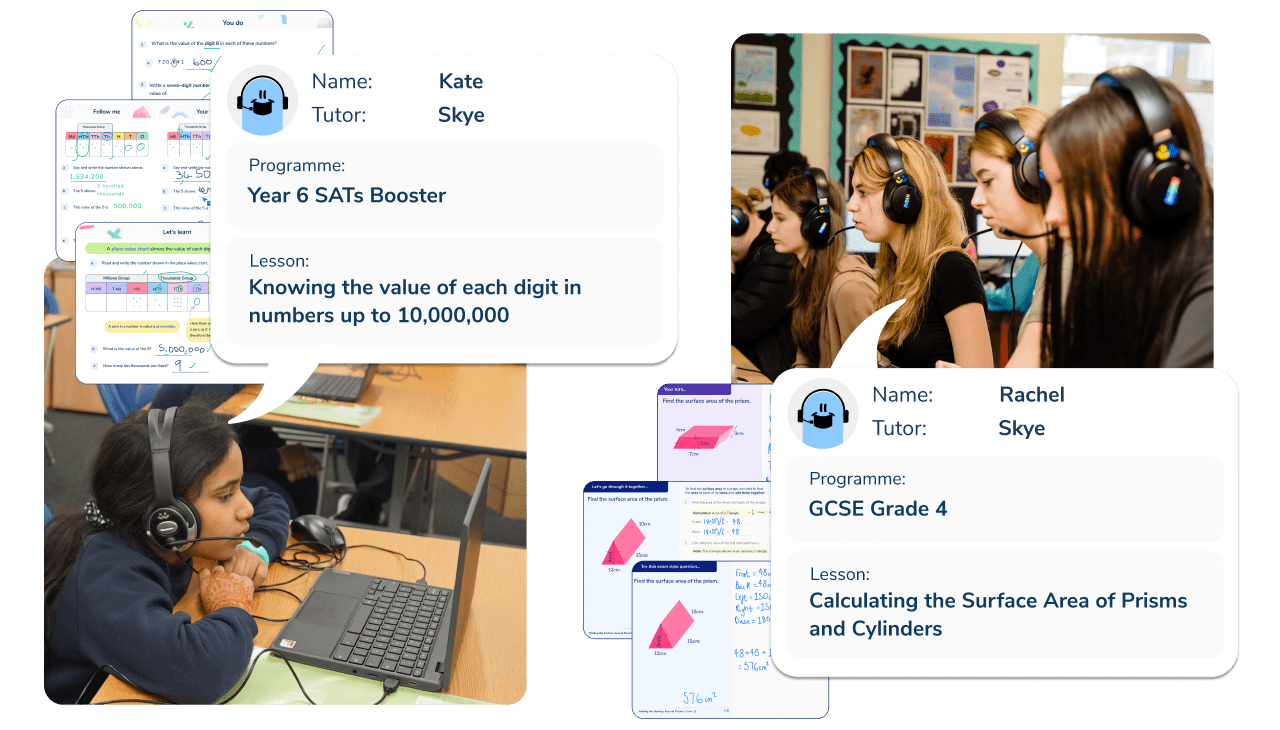
Meet Skye, the voice-based AI tutor making maths success possible for every student.
Built by teachers and maths experts, Skye uses the same pedagogy, curriculum and lesson structure as our traditional tutoring.
But, with more flexibility and a lower cost, schools can scale online maths tutoring to support every student who needs it.
Watch Skye in actionHow can 100 squares be used in the classroom?
100 squares are a great resource because they are such a versatile concrete maths resource. As they can be used in so many topics, children become familiar with them and they are confident to use them independently in the classroom.
100 squares are also one of the most cost-effective mathematics resources as they can be printable and often don’t even need to be laminated, depending on their use. If you’re looking for something more durable, you can also purchase mini-whiteboards with number squares printed on one side.
100 squares can also be used alongside other maths manipulatives.
100 squares for place value
A 100 square is really useful to support knowledge of the place value of 2-digit numbers.
Children can use them to support their understanding that as you move one place to the right, the number gets one bigger and one place to the left is one smaller. This is similar for moving up and down a column too.
In early years, you may focus on the first two rows of the number square, leaving the rest for children to explore at their leisure. They could use their fingers to follow when counting up or down to ensure their confidence with 1-1 correspondence. You may then move to ‘missing number’ problems by covering a number and asking children which number has been covered and how they know. This supports early reasoning.
In Key Stage 1, as children begin to learn about numbers to 100, the hundred square becomes a useful tool for being able to recognise the place value of the digits in a two-digit number and how they relate to other numbers. With the layout of a hundred square, children can see the relationships of one more/less and ten more/less.
100 squares for addition and subtraction
100 squares can be used to help children understand addition and subtraction within one hundred.
Initially, they will begin on one number, counting on or back in single steps to find the answer, much like they would on a number line. However, as they become more confident in their knowledge of numbers, it would be wise to encourage them to partition a number into tens and ones, adding or subtracting each of these individually.
100 squares for times tables
100 squares can help children to understand number patterns and therefore help them to recognise their times tables.
For example, if they coloured in every multiple of two on the grid, they would see that every even number is coloured and that the pattern of one coloured, one not is repeated continuously. Similar patterns are obvious for the ten and five times tables.
Additionally, when children are first learning multiples of any number, being able to count on each time will help them to find and learn the numbers.
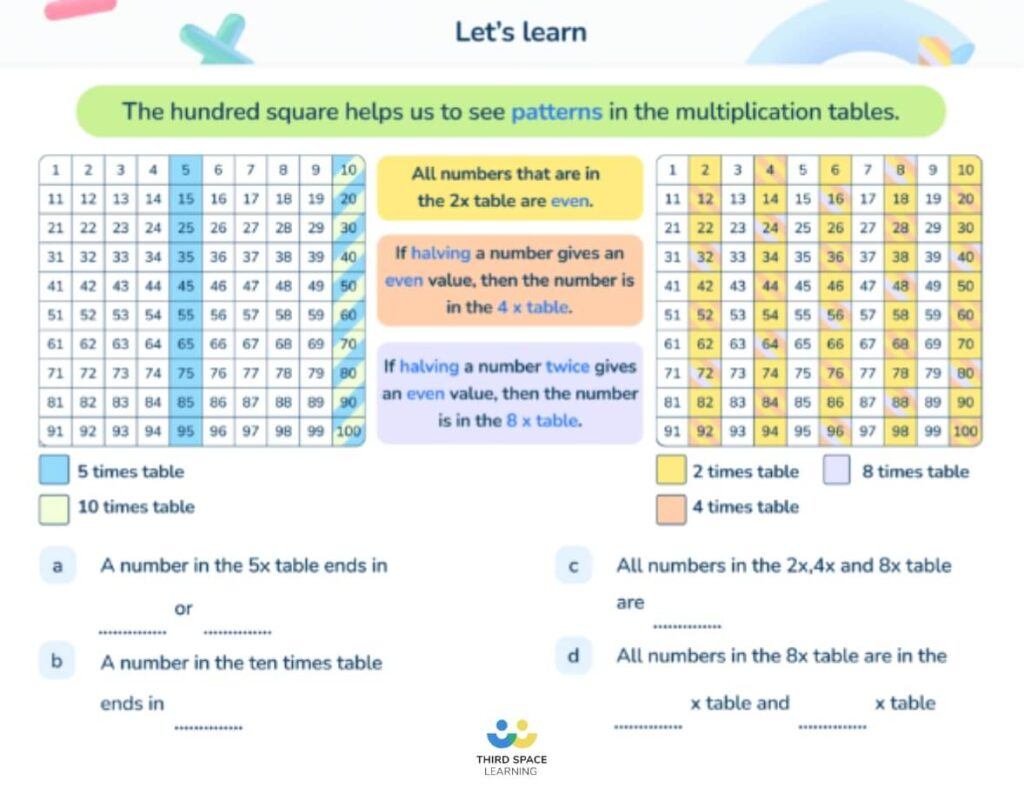
pupils use hundred squares to recognise patterns in the multiplication tables.
100 squares for fractions
Fractions for kids can be challenging. Number squares – particularly blank ones – can help children to understand fractions, particularly tenths and hundredths.
Since the grid is in ten rows and ten columns, the resource lends itself to being split into ten equal parts to represent tenths. Similarly, since there are one hundred parts, it is perfect for representing hundredths too.
100 squares for decimals
A blank number square is a great resource to represent fractions, decimals and percentages.
It can be used to colour a specific value or teachers can write, type or find a worksheet that has the decimal equivalents written into it in exactly the same way. If children have been familiar with hundred squares from earlier in their mathematical understanding, this will help them to see the relationship between the decimal numbers to 1.
100 squares for percentages
As percentages are literally parts per one hundred, the number square can be used to help children understand percentages and their relationships to fractions and decimals.
10 activities using a 100 square for the primary classroom
As you can see, 100 squares are versatile and can be used to support teaching in a number of topics. Below, we’ve included ten practical activities using 100 squares in the primary classroom.
1. Cover a number
Suitable for
EYFS, Year 1, Year 2
What you’ll need
Hundred squares and counters
Instructions
Give pupils a number square with a number covered. Ask them what the missing number is and how they know.
Tips for Teachers
Use this as an opportunity to encourage number talk and reasoning.
2. One or ten more or less
Suitable for
EYFS, Year 1
What you’ll need
Hundred squares
Instructions
Choose a number and ask pupils to find one more/less or ten more/less. Ask them what they notice.
Tips for teachers
To begin with, pupils will need to count ten spaces to find ten more or less. This will help them to understand how the hundred square works.
Eventually, pupils should be able to move one space up or down, as well as notice that only the tens digit changes – the ones doesn’t.
3. Missing numbers
Suitable for
Year 1, Year 2
What you’ll need
A 100 square square with missing numbers (you can create this yourself using a blank number square)
Instructions
Ask pupils to fill in the missing numbers using their understanding of place value and number patterns in a hundred square.
Tips for teachers
This activity can be modified when children are more comfortable with place value and number sense to include only part of the hundred square.
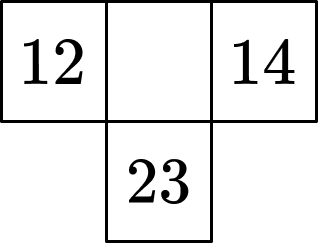
4. Number Patterns
Suitable for
All year groups
What you’ll need
100 squares, counters
Instructions
Pupils cover multiples of any number you choose. They then look for patterns.
Tips for teachers
This is a really good activity to encourage the use of mathematical vocabulary.
5. Jigsaw
Suitable for
Year 2
What you’ll need
A hundred square, scissors
Instructions
Cut the hundred squares into pieces of varying sizes. The pupils need to put it back together using their knowledge of place value and number patterns.
6. Race Game
Suitable for
Year 1, Year 2
What you’ll need
Dice, hundred square, counters
Instructions
Pupils begin on either 1 (for an addition game) or 100 (for a subtraction game) and race to the other side of the game board.
They roll the dice and move the required number of spaces.
Tips for teachers
Pupils could do this by counting with one-to-one correspondence or be challenged further by having to do the calculation first.
E.g If they are currently on 42 and they roll 5, they need to calculate that they will move to 47 before they move their counter.
7. Number bonds
Suitable for
EYFS, Year 1, Year 2
What you’ll need
Hundred squares
If using laminated hundred squares, dry wipe pens could be used. If they’re not laminated, counters may be helpful.
Instructions
Ask pupils to find number bonds to a given number.
8. Addition and subtraction calculations
Suitable for
Year 1, Year 2
What you’ll need
Hundred squares, dry wipe pens/pencils
Instructions
Use the hundred square in a similar way to a number line to support addition and subtraction.
Tips for teachers
As with activity number 2 (One or ten more or less), children are likely to begin this by counting in ones. Later on, they should be able to partition numbers into tens and ones to be able to complete their calculations easier and quicker.
9. Times tables
Suitable for
Year 2, Year 3, Year 4 (you can adapt for each year group by choosing different times tables)
What you’ll need
Hundred squares
If using laminates, dry wipe pens could be used. If they’re not laminated, counters may be helpful
Instructions
Highlight all of the multiples of the times table you are focussing on. Then, ask pupils what they notice.
Tips for teachers
Try to guide pupils away from explaining shape patterns (‘it’s diagonal’) and into number patterns (‘in each number, the digits add up to 9’).
10. What fraction/decimal/percentage is shaded?
Suitable for
Year 4, Year 5, Year 6
What you’ll need
Blank hundred squares (either the teacher could colour them, or the pupils could)
Instructions
Give pupils a hundred square with a section shaded. Ask them to express the amount that is shaded as a fraction, decimal or percentage.
Tips for teachers
You could also ask them to do the same with the unshaded part. This would help them to understand how to produce a whole.
100 squares worked examples
1. What are the missing numbers?
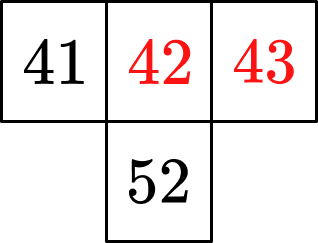
Here, the pupil has used their knowledge of a hundred square and place value to know that the number in the middle square has to be one more than 41 and ten less than 52. They can then work out the number next to that.
2. Class 2A need 32 pieces of fruit and 2B need 27 pieces of fruit. How many pieces of fruit are needed altogether?
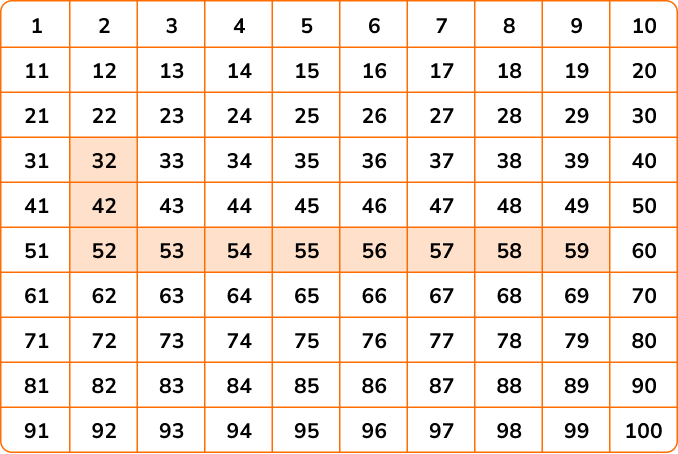
Here, the child has started with 32 and added 20 by moving two places down and then the 7 by moving seven places to the right. They have found that the answer is 59.
3. What fraction of this shape is shaded? What fraction is unshaded? How do you know?
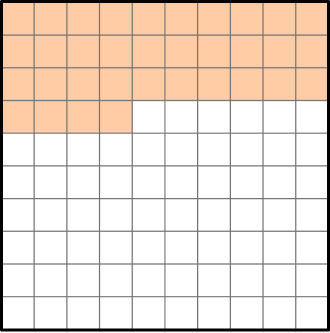
34/100 of the shape is shaded because there are 100 equal parts altogether and 34 of those are shaded.
66/100 are unshaded. I know this because 34+66=100 and in the whole there are 100/100.
100 square practice questions
1. What are the missing numbers?
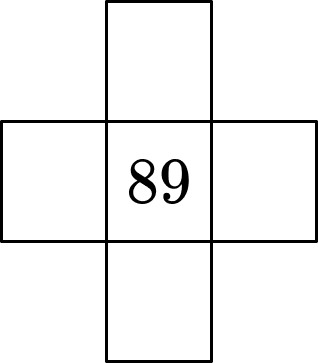
Answer: 79 in the top box, 88 to the left, 90 to the right and 99 at the bottom.
2. What number is covered? How do you know?
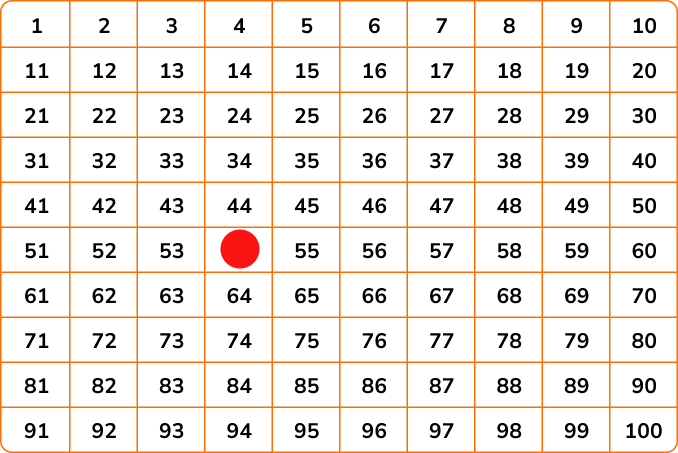
Answer: 54 is covered because it is a number one more than 53, one less than 55, ten more than 44 and ten less than 64.
Children would probably only say one of these reasons.
3. There are 75 tickets for Year 2’s school play. 42 have been sold. How many are there left to sell?
Answer: 33 tickets left
4. How much of the hundred square is shaded? Give your answer as a fraction and a decimal.
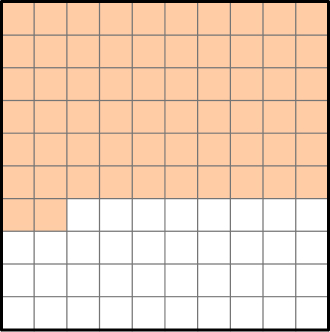
Answer: 62/100 which is 0.62
Read more:
A hundred square is a 10×10 grid with the numbers 1-100 in it.
No, 100 is a square number because 10×10=100 but it is not a cube number as it is not the product of three of the same whole number multiplied.
DO YOU HAVE STUDENTS WHO NEED MORE SUPPORT IN MATHS?
Skye – our AI maths tutor built by teachers – gives students personalised one-to-one lessons that address learning gaps and build confidence.
Since 2013 we’ve taught over 2 million hours of maths lessons to more than 170,000 students to help them become fluent, able mathematicians.
Explore our AI maths tutoring or find out about an online maths tutor for your school.
